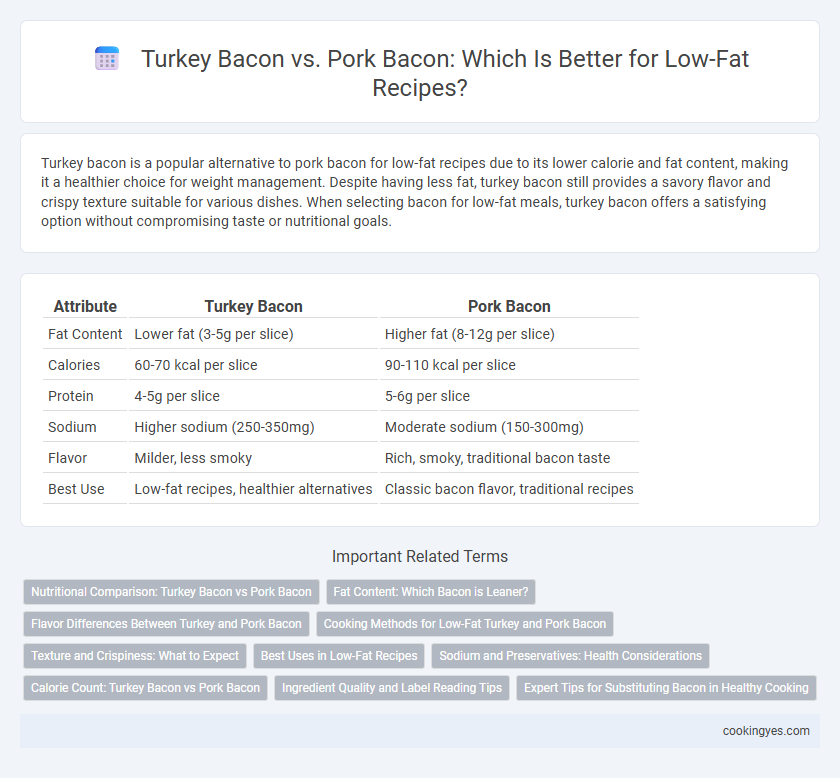Turkey bacon is a popular alternative to pork bacon for low-fat recipes due to its lower calorie and fat content, making it a healthier choice for weight management. Despite having less fat, turkey bacon still provides a savory flavor and crispy texture suitable for various dishes. When selecting bacon for low-fat meals, turkey bacon offers a satisfying option without compromising taste or nutritional goals.
Table of Comparison
| Attribute | Turkey Bacon | Pork Bacon |
|---|---|---|
| Fat Content | Lower fat (3-5g per slice) | Higher fat (8-12g per slice) |
| Calories | 60-70 kcal per slice | 90-110 kcal per slice |
| Protein | 4-5g per slice | 5-6g per slice |
| Sodium | Higher sodium (250-350mg) | Moderate sodium (150-300mg) |
| Flavor | Milder, less smoky | Rich, smoky, traditional bacon taste |
| Best Use | Low-fat recipes, healthier alternatives | Classic bacon flavor, traditional recipes |
Nutritional Comparison: Turkey Bacon vs Pork Bacon
Turkey bacon contains approximately 30-50% less fat and fewer calories than pork bacon, making it a preferred choice for low-fat recipes. It typically offers about 2-3 grams of fat per slice compared to 4-6 grams in pork bacon, contributing to reduced saturated fat intake. Protein content is slightly lower in turkey bacon, but the significant reduction in total and saturated fats supports healthier dietary options.
Fat Content: Which Bacon is Leaner?
Turkey bacon contains significantly less fat than traditional pork bacon, making it a leaner option for low-fat recipes. On average, turkey bacon has about 3 to 5 grams of fat per serving, compared to pork bacon's 8 to 12 grams. This reduction in fat content supports healthier cooking choices without sacrificing the savory, smoky flavor associated with bacon.
Flavor Differences Between Turkey and Pork Bacon
Turkey bacon offers a milder, slightly smoky flavor compared to the rich, savory taste of pork bacon, making it ideal for low-fat recipes where subtlety enhances other ingredients. Pork bacon's robust, fatty profile delivers a stronger umami presence and crisp texture that turkey bacon lacks. Choosing turkey bacon reduces fat content without sacrificing the essential smoky essence that complements health-conscious dishes.
Cooking Methods for Low-Fat Turkey and Pork Bacon
Low-fat turkey bacon often requires baking or grilling to minimize added fats, while pork bacon benefits from pan-frying on a non-stick surface with minimal oil to reduce grease. Using methods like microwaving turkey bacon can also effectively render fat without compromising texture, whereas pork bacon yields better flavor and crispness when cooked slowly at lower heat. Both types respond well to draining excess grease on paper towels post-cooking to further cut fat content in low-fat recipes.
Texture and Crispiness: What to Expect
Turkey bacon offers a leaner alternative to pork bacon, featuring a firmer texture and slightly drier crispiness due to its lower fat content. Pork bacon delivers a richer, more succulent texture with a higher fat ratio that crisps up more evenly and remains tender. In low-fat recipes, turkey bacon provides a healthier crunch but may require additional cooking time or oil to achieve the desired crispiness compared to traditional pork bacon.
Best Uses in Low-Fat Recipes
Turkey bacon offers a leaner alternative to traditional pork bacon, containing significantly less saturated fat and calories, making it ideal for low-fat recipes. It performs best in dishes like salads, wraps, and breakfast scrambles where a smoky flavor is desired without excess grease. Pork bacon, while richer and more flavorful, is better suited for recipes that can accommodate higher fat content, such as hearty soups or pasta dishes requiring added depth.
Sodium and Preservatives: Health Considerations
Turkey bacon typically contains lower fat content but often has higher sodium levels and added preservatives compared to pork bacon, which can impact heart health and blood pressure. Choosing low-sodium, nitrate-free turkey bacon options can reduce intake of harmful additives while maintaining a leaner protein source. Monitoring sodium and preservative content is essential for health-conscious individuals aiming to optimize their low-fat recipes without compromising flavor or safety.
Calorie Count: Turkey Bacon vs Pork Bacon
Turkey bacon contains approximately 30 to 50 calories per slice, significantly lower than pork bacon, which averages around 42 to 50 calories per slice but often has higher fat content. The reduced fat in turkey bacon contributes to its lower calorie count, making it a preferred option for low-fat recipes. Choosing turkey bacon helps maintain flavor while supporting calorie-conscious dietary goals.
Ingredient Quality and Label Reading Tips
Turkey bacon, made from leaner turkey meat, typically contains lower fat content compared to traditional pork bacon, making it a healthier choice for low-fat recipes. When selecting turkey bacon, carefully examine ingredient lists for additives like sugar, sodium, and preservatives, which can affect nutritional value. Reading labels for sodium levels and nitrate content ensures you choose a high-quality product aligned with low-fat and clean-eating goals.
Expert Tips for Substituting Bacon in Healthy Cooking
Turkey bacon contains significantly less fat and fewer calories than traditional pork bacon, making it an ideal substitute for low-fat recipes without sacrificing flavor. Experts recommend choosing nitrate-free turkey bacon options to maintain health benefits while enhancing taste and texture. For best results, cook turkey bacon on a non-stick surface or in the oven to reduce added fats and achieve a crispy finish.
Turkey bacon vs pork bacon for low-fat recipes Infographic

 cookingyes.com
cookingyes.com